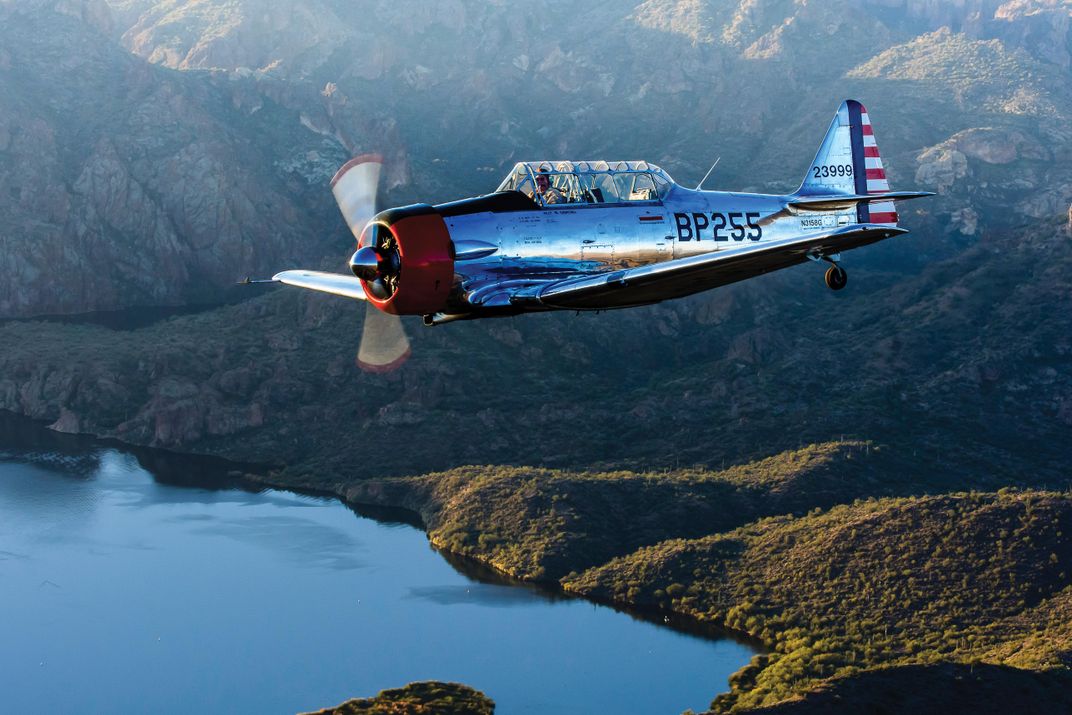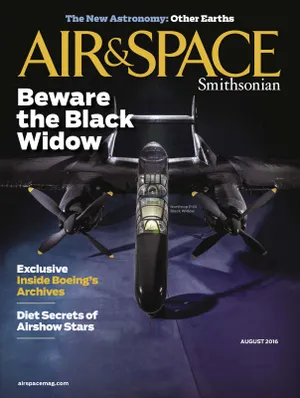Warbird-Watching Over Arizona
Rule number one for aerial photography: Don’t lose your camera in the windstream.
/https://tf-cmsv2-smithsonianmag-media.s3.amazonaws.com/filer/b3/08/b3084218-a7ad-448c-96e3-c36f7b69314a/17a_aug2016_at6texansmcauliffeselfie0840_live.jpg)
The pilot’s voice crackled in my headset: “If your harness unbuckles, close the canopy and let me know. We don’t want you flying out of the plane.” This was not the “seatbacks up and tray tables stowed” safety briefing I was used to, but then, I was strapped into the rear cockpit of a 72-year-old North American Aviation AT-6 Texan.
It was early on a Sunday morning in November 2014. The winds were calm and just a few wispy clouds were painted across a clear blue sky—a perfect day for flying. I was at Falcon Field in Mesa, Arizona, attending an aviation photography workshop taught by the widely published wildlife and aviation photographer Moose Peterson. Today I was checking off two longtime dreams: to fly in a World War II warbird, and to practice air-to-air photography.
With their shiny fuselages, colorful insignias, and personalized nose art, vintage airplanes are wonderful photographic subjects. I’d been shooting historic warbirds on the ground for years, but to get the dramatic in-flight images I dreamed of, I would shoot from the open cockpit of a Texan cruising at 160 mph. My target? Another Texan flying in close formation with my own.
While not as fast or famous as World War II fighters like North American’s P-51 Mustang, the AT-6 Texan made wartime contributions that were essential to victory. Several hundred thousand pilots from the U.S. Army and Navy—and from more than 30 military air services in other countries—learned to fly in Texans. This included 2,400 British pilots who trained in the airplane (called Harvards by the Brits) right here at Falcon Field. Today, the big trainers were being flown by their owners, Brian Churchill and his brother Dale. They run the Arizona-based educational nonprofit Wings of Flight Foundation, and they sometimes fly B-25s too.
With a swarm of butterflies in my stomach, I scrambled up onto the wing and then into the rear cockpit of a Texan built in 1942. Its most recent military service had been with the South African Air Force in the mid-1990s, and the SAAF insignias and bright orange paint scheme remained.
Dressed in a tan canvas aviator’s helmet and a headset that looked like I’d swiped it from the set of the 1951 John Wayne movie Flying Leathernecks, I buckled myself in and used a wide black strap of military-grade webbing to secure my camera so it couldn’t slip out of my hands. Anything leaving the cockpit could potentially bring down one of the aircraft, I’d been warned.
Nearby, Dale sat at the controls of the Texan that would be my subject that day, a ghost from Falcon Field’s past. The airplane’s exquisite aluminum fuselage had the same livery as the Texans that British pilots had flown from the field during the war: dark red cowling, alternating horizontal red and white stripes across the rudder, and red, white, and blue stars on each wing—a stunning model for the day’s shoot.
After engine startup and preflight checks were completed, we taxied to the end of runway 4R. Dale positioned his Texan just behind and to the left of ours. The pilots pushed their throttles forward, and the deep growl of two 600-horsepower Pratt & Whitney R-1340 radial engines reverberated across the desert floor. My butterflies vanished as we shot down the runway.
When the Texans hit takeoff speed they leapt from the tarmac like the high-jumping African antelope painted on the side of our aircraft, the emblem of the South African Air Force. The aircraft climbed rapidly in formation, their wingtips separated by less than the width of a lane of freeway. I began to shoot as fast as my Nikon’s shutter would fire.
I let the nose of my long lens inch outside of the cockpit, and immediately felt the oncoming air violently grab hold of it. Lesson learned: If I allowed my lens to poke too far into the airstream, I could break it—and maybe my hand too.
Our flight plan took us northeast toward the Superstition Mountains. As we climbed, the roads, ranch houses, and orange groves of Mesa receded, replaced by scrubby sagebrush and tall green saguaro cacti. When the altimeter hit 2,000 feet, the pilots leveled out. My Texan was equipped with a rear seat that rotated 360 degrees for gunnery practice. This feature was also perfect for air-to-air photography, providing unobstructed sight lines out the sides and back of the aircraft.

My heart rate quickened as I anticipated spinning my seat 180 degrees while traveling at 160 mph in a small, open cockpit. I pulled my arms and legs in to get skinny, and kicked a small lever under the seat with my heel which let me spin the seat around with my feet. I was careful not to hit the rudder pedals; Brian didn’t need any help flying the airplane.
As the seat locked in its backward-facing position, my eyes widened.
The view was breathtaking. To my left, Dale’s shiny silver Texan seemed to float just below our own, perfectly shadowing our every move. The desert landscape—cacti and sage-covered mountains with the golden morning sun just beginning to meander over the mountaintops—was reflected in its gleaming fuselage. Over the next 25 exhilarating minutes, I shot more than 1,000 photos.
Brian would periodically suggest maneuvers to get good shots. “Let’s have Dale move his plane over by those clouds,” he suggested, knowing that the clouds and deep blue sky would form a beautiful backdrop for the shiny Texan. As I grew more comfortable, I developed the confidence to begin to direct the shoot myself. I would ask for the subject aircraft to be repositioned against a certain background, or changing where it flew with respect to our airplane.
“Ask Dale to move out 30 feet,” I said over the intercom, then heard Brian relay my request to Dale over the radio. Each time the Texan relocated, I shot another burst.
When photographing airplanes with propellers, you use very slow shutter speeds to blur the prop, which gives the aircraft a look of motion. To keep the Texan in focus at that shutter speed, I had to try to hold over five pounds of camera and lens rock steady in a vibrating airplane. My arms would be sore for a day after the flight.
As one of the fastest half-hours of my life neared its end, one opportunity remained. Dale had warned me to be ready on our return to the field, as he would leave formation with a tight breaking turn.
As he executed the maneuver, his Texan rapidly pulled up and away, flashing its underside at us. The sequence of photos I snapped then are my ultimate souvenir from the day—lasting mementos of my first, but definitely not last, warbird ride, and a shoot that took my photography to new heights.
When can I fly again?
